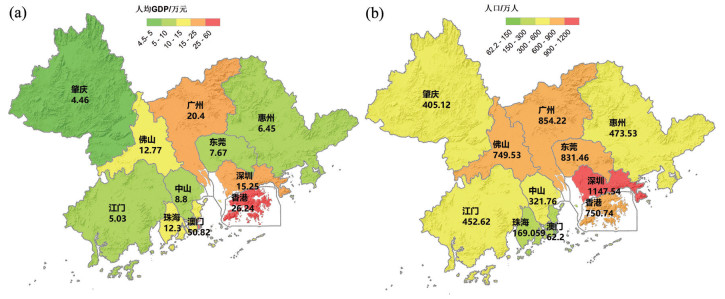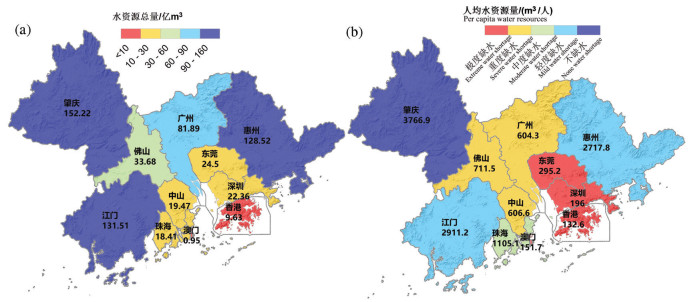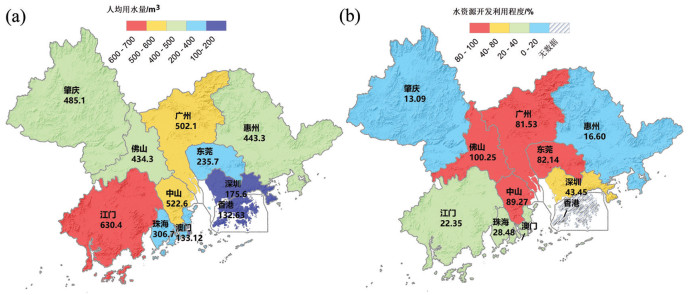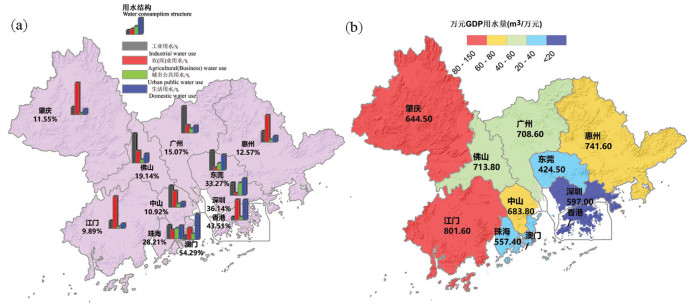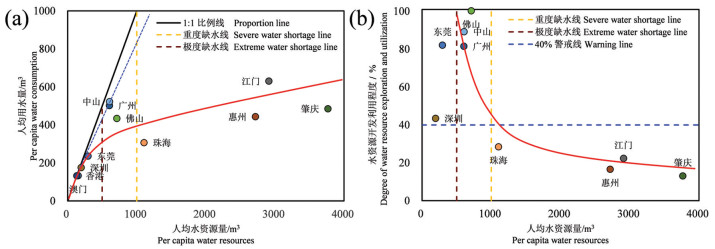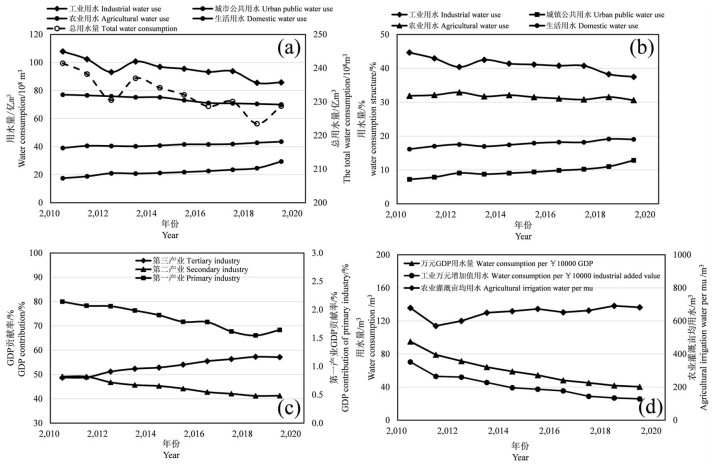Water resources in the Guangdong-Hong Kong-Macao Greater Bay Area and its co-evolution trend with social economy: A comparative study with the international bay area
-
摘要:
粤港澳大湾区(以下简称大湾区)水资源现状及其演化规律关系到该区社会经济的高质量发展。本文对大湾区"9市+2区"近10年的社会经济与水资源现状及其协同演化规律进行分析研究。结果显示:目前大湾区供水主要依赖地表水,水资源的分布与区域经济发展不协调,作为区域发展核心引擎的香港、澳门、深圳(极度缺水)以及广州(重度缺水)人均水资源量过低。广州、佛山、中山、东莞(>80%)以及深圳(>40%)水资源开发利用程度高,水资源供需压力大。通过归因分析得到大湾区的水资源利用现状与社会经济的协同规律:产业结构影响用水结构以及水资源开发利用程度,控制用水效率。区域内产业结构与发展趋势,及其与世界湾区的对比分析验证了产业结构理论中的"配第-克拉克定理"。随着大湾区经济持续的发展与产业结构优化,大湾区用水效率将提高,人均用水量会逐步降低。同时城市公共用水、生活用水需求量将持续上升,需确保大湾区供水设施,供水量及供水安全满足未来社会经济发展需求。
Abstract:The current situation and evolution of water resources in the Guangdong-Hong Kong-Macao Greater Bay Area is crucial to the high-quality development of the region's social economy. The study focuses on the current situation of water resources in the "9 Cities +2 Municipalities" of the Greater Bay Area in recent ten years and its co-evolution trend with social economy. The results show that the present water supply in the Greater Bay Area mainly relies on surface water, and the distribution of water resources is not equilibrated with regional economic development. As the core engine of regional development, Hong Kong, Macao, Shenzhen (extremely short of water) and Guangzhou (severely short of water) have a low per capita water resources. Guangzhou, Foshan, Zhongshan, Dongguan (>80%) and Shenzhen (>40%) have a high degree of water resources development and utilization, and the pressure of water resources supply and demand is large. The synergetic law between the current situation of water resources utilization and social economy in the Greater Bay area, resulted from attribution analysis, indicates that industrial structure influences the water consumption structure and controls the water consumption efficiency. The industrial structure and development trend in the region and the comparative analysis with the bay area in the world verify the "Petty Clark theorem" in the theory of industrial structure. With the continuous economic development of the Greater Bay Area, the industrial structure will be optimized forward, water consumption efficiency will increase, and per capita water consumption will gradually decrease. Meanwhile, the demand for urban public water and domestic water will continue to rise, and the water supply facilities, water quality and water supply security in the Greater Bay Area need to be ensured to meet the future social and economic development demands.
-
-
表 1 大湾区各产业GDP贡献率(%)
Table 1 Contribution of industries to GDP in the Greater Bay Area(%)

表 2 珠三角九市供水量及供水结构
Table 2 Water supply and water supply structure of nine cities in Pearl River Delta

表 3 珠三角9市农业亩均灌溉用水量及万元工业增加值用水量(m3)
Table 3 The irrigation water consumption per Mu of agriculture and the water consumption per ten thousand yuan of added industrial value in the nine cities in the Pearl River Delta(m3)

表 4 水资源现状归因分析
Table 4 Attribution analysis of current water resources situation

表 5 国际湾区经济、人口以及产业对比
Table 5 Comparison of economy, population and industry of international bay area

表 6 国际湾区水资源情况综合对比
Table 6 Comprehensive comparison of water resources in the international bay area

-
An Xindai. 2007. Current status of management and regulation of the Yellow River water resources and future prospect[J]. China Water Resources, 13: 16-19. (in Chinese with English abstract). http://en.cnki.com.cn/Article_en/CJFDTOTAL-SLZG200713011.htm
Annual Survey FY 2018-2019. Bay Area Water Supply and Conservation Agency.
Cao Jing, Zhang Wenzhong. 2020. Evolution and synergy of urban construction land and economic growth patterns in Guangdong-Hong Kong-Macao Greater Bay Area[J]. Economic Geography, 40(2): 52-60 (in Chinese with English abstract). http://www.researchgate.net/publication/342639593_Characteristics_of_Spatial_and_Temporal_Evolution_and_Investigation_of_Air_Pollution_in_Guangdong-Hong_Kong-Macao_Greater_Bay_Area_Based_on_Ground-Space_Observation_Data
Cao Jing, Zhang Wenzhong. 2020. The influence of urban innovation input on green economy efficiency in different periods: A case study of the Guangdong-Hong Kong-Macao Greater Bay Area[J]. Geographical Research, 39(9): 1987-1999 (in Chinese with English abstract).
Chen Jianjun, Huang Jie. 2020. A research on the high-quality development of regional economy in the past 70 years since the founding of the P.R.C. [J]. Journal of Anhui University (Philosophy and Social Sciences Edition), 4: 144-156(in Chinese with English abstract).
Feng Shangyou. 2000. Introduction to Sustainable Use and Management of Water Resources[M]. Beijing: Science Press (in Chinese).
Gao Zhen, Huang Bensheng, Qiu Jing, Tan Chao, Liu Da, Ji Hongxiang, Zhang Zhilin. 2020. Research on the water security issues and suggestions in Guangdong-Hong Kong-Macao Greater Bay Area[J]. China Water Resources, 893(11): 22-25.
Guo Haipeng, Zhang Zuochen, Cheng Guoming, Li Wenpeng, Li Tiefeng & Jiao Jiu Jimmy. 2015. Groundwater-derived land subsidence in the North China Plain[J]. Environmental Earth Sciences, 74(2): 1415-1427. doi: 10.1007/s12665-015-4131-2
Howard Frederick Matthai, William Back R P. Orth. 1957. Water Resources of the San Francisco Bay area, California.
Li Junfei, Yang Leisan, Meng Fansong. 2019. Discussion on water problems of Guangdong-Hong Kong-Macao Greater Bay Area[J]. China Water & Wastewater, 494(18): 21-25(in Chinese with English abstract). http://en.cnki.com.cn/Article_en/CJFDTotal-GSPS201918010.htm
Liu Chang, Lin Shenhui, Jiao Xueyao, Shen Xiaoxue, Li Ruili. 2019. Problems and treatment countermeasures of water environment in Guangdong-Hong Kong-Macao Greater Bay Area[J]. Acta Scientiarum Naturalium Universitatis Pekinensis, 55(6): 1085-1096. http://en.cnki.com.cn/Article_en/CJFDTotal-BJDZ201906012.htm
Lu Yaoru. 2014. Build ecological civilization and protect groundwater resources to promote sustainable development and utilization[J]. Acta Geoscientica Sinica, 35(2): 129-130(in Chinese with English abstract).
Qin Chenglin, Liu Liling, Qin Wenhao. 2017. On the development strategy of the urban agglomeration in the Guangdong-Hong Kong-Macao Greater Bay Area[J]. Regional Economic Review, 5: 113-118(in Chinese with English abstract). http://en.cnki.com.cn/Article_en/CJFDTOTAL-QYHL201705014.htm
Ren Chongfeng, Guo Ping, Li Mo, Li Ruihuan. 2016. An innovative method for water resources carrying capacity-metabolic theory of regional water resources[J]. J. Environ. Manag., 167: 139-146. doi: 10.1016/j.jenvman.2015.11.033
Varis Olli, Vakkilainen Pertti. 2001. China's 8 challenges to water resources management in the first quarter of the 21st century[J]. Geomorphology, 41(2/3): 93-104. http://www.researchgate.net/profile/Varis_Olli/publication/234116885_China's_8_Challenges_to_Water_Resources_Management_in_the_First_Quarter_of_the_21st_Century/links/0fcfd50f564bb64de5000000.pdf
Vorosmarty Charles J, Green Pamela, Salisbury, Lammers B Richard. 2000. Global water resources: vulnerability from climate change and population growth[J]. Science, 289: 284-288. doi: 10.1126/science.289.5477.284
Wang Hao, Wang Jianhua, Qin Dayong, Chen Chuanyou, Jiang Dong, Yao Zhijun. 2002. The study on water resources assessment and subject system of water resources study on modern times[J]. Advance in Earth Sciences, (1): 13-18(in Chinese with English abstract). http://www.researchgate.net/publication/319151419_THE_STUDY_ON_WATER_RESOURCES_ASSESSMENT_AND_SUBJECT_SYSTEM_OF_WATER_RESOURCES_STUDY_ON_MODERN_TIMES
Wen Qi, Liu Yansui, Ding Jinmei, Chen Feng. 2008. Water resources pressure and ecosystem health in Yinchuan City[J]. Resources Science, (2): 89-95(in Chinese with English abstract).
Wei Zuolei. 2004. Empirical analysis of the tertiary industry development driving employment in China[J]. Finance & Trade Economics, (3): 80-85 (in Chinese).
Wu Aimin, Jin Jihong, Song Bo. 2016. Water safety issues of China and ensuring roles of groundwater[J]. Acta Geoscientica Sinica, 90(10): 2939-2947 (in Chinese with English abstract). http://en.cnki.com.cn/Article_en/ http://search.cnki.net/down/default.aspx?filename=DZXE201610030&dbcode=CJFD&year=2016&dflag=pdfdown
Wu Bin, Wang Sai, Wang Wenxiang, An Yonghui. 2019. Impact of future climate change on water resources in the arid regions of Northwest China based on surface water-groundwater coupling model: A case study of the middle reaches of the Heihe River[J]. Geology in China, 46(2): 157-168(in Chinese with English abstract). http://en.cnki.com.cn/Article_en/CJFDTotal-DIZI201902014.htm
Xia Jun, Shi Wei, Luo Xinping, Hong Si, Ning Like, Christopher J Gippel. 2015. Revisions on water resources vulnerability and adaption measures under climate change[J]. Advances in Water Science, 26(2): 279-286 (in Chinese with English abstract).
Yang Dawen, Li Chong, Hu Heping, Lei Zhidong, Yang Shixiu, Kusuda Tetsuya, Koike Toshio, Musiake Katumi. 2004. Analysis of water resources variability in the Yellow River of China during the last half century using historical data[J]. Water Resources Research, 40(6): 308-322. http://d.wanfangdata.com.cn/periodical/ChlQZXJpb2RpY2FsRW5nTmV3UzIwMjAxMDI4EiBkOGNkMzRkNTI2Y2RmN2Q3ZTMzNTc0NTNmNGVhN2FiNBoIaDlieHBwc2g%3D
Zhang Jiexuan, Li ming. 2016. Study on environmental pollution control in Guangdong Province[J]. Resources Economization & Environmental Protection, (7): 147-147(in Chinese with English abstract).
Zhang Qiliang. 2014. High income country (region) measurement standard and related concept[J]. China Statistics, (12): 28-30(in Chinese).
Zhu Peng, Lu Chunxia, Zhang Lei, Cheng Xiaoling. 2008. Variability of water resource in the Yellow River Basin of past 50 years, China[J]. Water Resources Management, 23(6): 1157-1170. doi: 10.1007%2Fs11269-008-9320-2.pdf
Zhu P, Lu C, Cheng Z X. 2009. Urban fresh water resources consumption of China[J]. Chinese Geographical Science, 19(3): 219-224. doi: 10.1007/s11769-009-0219-5
安新代. 2007. 黄河水资源管理调度现状与展望[J]. 中国水利, 13: 16-19. https://www.cnki.com.cn/Article/CJFDTOTAL-SLZG200713011.htm 曹靖, 张文忠. 2020. 不同时期城市创新投入对绿色经济效率的影响——以粤港澳大湾区为例[J]. 地理研究, 39(09): 1987-1999. https://www.cnki.com.cn/Article/CJFDTOTAL-DLYJ202009004.htm 曹靖, 张文忠. 2020. 粤港澳大湾区城市建设用地和经济规模增长格局演变及协同关系[J]. 经济地理, 40(2): 52-60. https://www.cnki.com.cn/Article/CJFDTOTAL-JJDL202002006.htm 陈建军, 黄洁. 2020. 新中国区域经济发展70年: 走向高质量发展之路[J]. 安徽大学学报(哲学社会科学版), 4: 144-156. https://www.cnki.com.cn/Article/CJFDTOTAL-ADZS202004017.htm 冯尚友. 2000. 水资源持续利用与管理导论[M]. 北京: 科学出版社. 高真, 黄本胜, 邱静, 谭超, 刘达, 吉红香, 张之琳. 2020. 粤港澳大湾区水安全保障存在的问题及对策研究[J]. 中国水利, 893(11): 22-25. https://www.cnki.com.cn/Article/CJFDTOTAL-SLZG202011006.htm 李骏飞, 杨磊三, 孟凡松. 2019. 粤港澳大湾区面临的水问题探析[J]. 中国给水排水, 494(18): 21-25. https://www.cnki.com.cn/Article/CJFDTOTAL-GSPS201918010.htm 刘畅, 林绅辉, 焦学尧, 沈小雪, 李瑞利. 2019. 粤港澳大湾区水环境状况分析及治理对策初探[J]. 北京大学学报(自然科学版), 55(6): 1085-1096. https://www.cnki.com.cn/Article/CJFDTOTAL-BJDZ201906012.htm 卢耀如. 2014. 建设生态文明保护地下水资源促进可持续开发利用(代序)[J]. 地球学报, 35(2): 129-130. https://www.cnki.com.cn/Article/CJFDTOTAL-DQXB201402001.htm 覃成林, 刘丽玲, 覃文昊. 2017. 粤港澳大湾区城市群发展战略思考[J]. 区域经济评论, (5): 113-118. https://www.cnki.com.cn/Article/CJFDTOTAL-QYHL201705014.htm 王浩, 王建华, 秦大庸, 陈传友, 江东, 姚治君. 2002. 现代水资源评价及水资源学学科体系研究[J]. 地球科学进展, 17(1): 12-17. doi: 10.3321/j.issn:1001-8166.2002.01.003 魏作磊. 2004. 对第三产业发展带动我国就业的实证分析[J]. 财贸经济, (3): 80-85. https://www.cnki.com.cn/Article/CJFDTOTAL-CMJJ200403014.htm 文琦, 刘彦随, 丁金梅, 陈锋. 2008. 银川市水资源胁迫与生态系统健康状况研究[J]. 资源科学, 30(2): 247-252. doi: 10.3321/j.issn:1007-7588.2008.02.013 吴爱民, 荆继红, 宋博. 2016. 略论中国水安全问题与地下水的保障作用[J]. 地质学报, 90(10): 2939-2947. doi: 10.3969/j.issn.0001-5717.2016.10.029 吴斌, 王赛, 王文祥, 安永会. 2019. 基于地表水-地下水耦合模型的未来气候变化对西北干旱区水资源影响研究——以黑河中游为例[J]. 中国地质, 46(2): 157-168. http://geochina.cgs.gov.cn/geochina/ch/reader/view_abstract.aspx?file_no=20190213&flag=1 夏军, 石卫, 雒新萍, 洪思, 宁理科, Christopher J Gippel. 2015. 气候变化下水资源脆弱性的适应性管理新认识[J]. 水科学进展, 26(2): 279-286. https://www.cnki.com.cn/Article/CJFDTOTAL-SKXJ201502019.htm 夏军, 翟金良, 占车生. 2011. 我国水资源研究与发展的若干思考[J]. 地球科学进展, 26(9): 905-915. https://www.cnki.com.cn/Article/CJFDTOTAL-DXJZ201109003.htm 张捷旋, 李明. 2016. 广东省环境污染治理问题研究[J]. 资源节约与环保, (7): 147-147. doi: 10.3969/j.issn.1673-2251.2016.07.127 张启良. 2014. 高收入国家(地区)的衡量标准及其相关概念[J]. 中国统计, (12): 28-30. https://www.cnki.com.cn/Article/CJFDTOTAL-ZGTJ201412014.htm



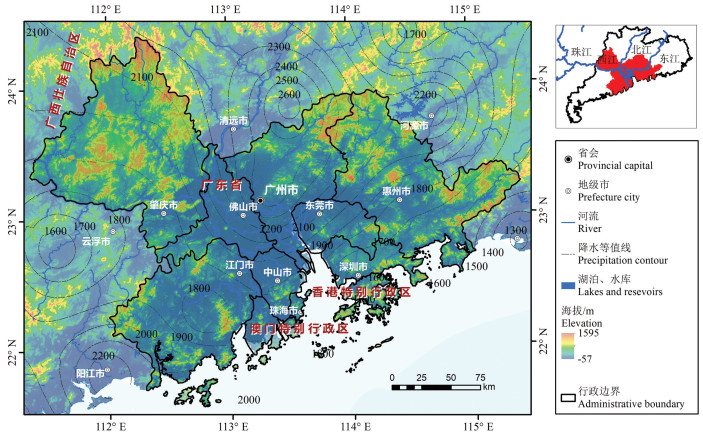
 下载:
下载:
